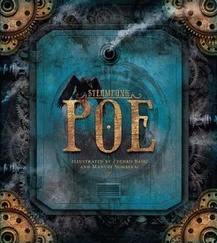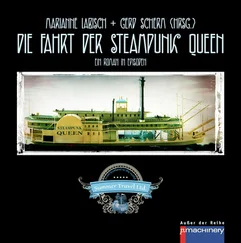He laughed. “Reliability first. Miniaturization second.”
Thilini hauled the wagon down to the docks and took up a vantage point where she could keep watch for the tall sails of the Southwind . Occasionally, part of a telegraph would come through; she’d transcribe the message and jot down the time in her notebook. The first time they’d gotten anything at all to transmit and be received through thin air, they’d both been overjoyed. But getting an entire message to go through over distances more than ten feet or so had proved a confoundingly difficult challenge.
Science, she mused, involved an awful lot of waiting and doing-over.
Her reverie was broken by the shouts of men. She stood. The Southwind had sailed into view … but she was too low in the sea, and listing so far to one side she looked in danger of capsizing. Had the ship broken its hull on a coral reef?
“She’s taking on water fast!” the stevedore shouted. “Every man with a boat, get out there! We need to get that cargo off!”
Two hours later, Thilini stood with her father as two deeply tanned dockworkers pulled the precious Swiss crates from the deck of a patamar that had been pressed into rescue duty. The crates were so waterlogged that she would not have been surprised to hear fish flopping inside them. The glass would be fine, provided it had not been mishandled, but she cringed at the corrosion the seawater would wreak on the delicate gears if they were not carefully rinsed, dried, and re-oiled.
“Please, get these back to my shop as quickly as you can,” her father told the men of the hired wagon.
“Yes, Herr Rothschild.” They quickly set to loading up the crates.
The stevedore approached them, shaking his head. He was a small, wiry man who looked Tamil but he wore a Catholic rosary over his loose cotton shirt and had a slight Portuguese accent. “A third of the cargo lost, and five sailors sent to the Almighty. The ship can’t be repaired in the water, so we need to find some way to haul ‘er in to dry-dock before she sinks. And I ain’t convinced she won’t just sink.”
“Was it a reef?” Thilini asked.
“If only!” the stevedore replied. “We could dodge a reef, but this … well, come see. Perhaps your papa can make heads or tails of this deviltry.”
Further down, another boat had come in bearing a broken plank from the hull. Not broken, she realized. Something had bitten it in half! Imbedded in the stout English timber was a shark’s tooth of far greater size than any she’d imagined. The biggest one she’d seen until then was about the size of a gold sovereign coin.
“Mein gott,” her father breathed. He laid his hand beside the protruding tooth; it was larger than his palm and outstretched fingers. “What leviathan could grow such a fang? Some type of cachalot whale?”
“ Carcharodon carcharias ,” came a voice behind them.
Thilini turned. Trincomalee’s resident naturalist, the retired physician Edward Kelart, was gazing at the tooth with grave concern. He leaned heavily against his silver-filigreed cane, which he’d needed to use ever since a hard voyage to England had nearly killed him two decades before.
“That tooth’s far too large to come from a great white shark,” her father countered.
“Indeed,” Dr. Kelart said. “But the tooth shape is distinct, and unmistakable. If it is not some ancient great white grown to immense size, it is a close cousin.”
The imported glass was in fine shape, and Thilini and her father were able to clean all the gears they needed for their submersible prototype. In just a few months, they had his latest invention ready to test in the waters. The gleaming fifteen-foot submarine was skinned in copper and steel, courtesy of the fine craftsmanship of the local metal smiths. The sub was sleek as a dolphin, with round fore and aft windows and triangular fins for stability. Her father’s patented, self-contained steam engine powered the screw-shaped propellers at the rear of the sub and electric headlights.
“This is just a miniature version of what I propose to build later,” her father remarked to the stevedore, who helped them guide the sub down the wooden ramp into the water. “We must test every aspect of the craft, of course.”
“You’re letting the girl pilot this thing?” Astonishment was plain on the stevedore’s face.
Thilini ignored him and focused on buttoning up her black rubber suit. The feel of the tight material against her legs was strange; she was used to airy saris and sarongs, but skirts would drag her down in the water if she needed to abandon ship. She hoped the coolness of the sea would help counteract the heat from the steam engine. Otherwise, she’d be stewed like a whiting in a parchment bag before her three hours of air were depleted.
“She knows every rivet and gear of this craft, and she is a far better swimmer than I,” her father said. “Further, we had to build the sub at such a limited scale that I can scarcely fit in it myself!”
The men helped her squeeze through the top hatch of the sub.
“Don’t go out of the shallows at first, and if the craft is sound, don’t take her farther than Pigeon Island,” her father admonished.
“I won’t,” she promised.
They sealed the hatch above her, and moments later the sub lurched as the men pushed it into the water. Thilini said a quick prayer and pulled the lever to start the steam engine. The whole craft shook as the fire ignited in the belly of the sub and the boiler began to steam. She busied herself checking pressure and temperature gauges, then went around the inside of the craft, checking all the brass and copper pipe fittings and wall panels for leaks.
After a half-hour, she was certain the engine was operating as expected and the craft was watertight. She settled in the leather-padded pilot’s chair and cautiously steered the craft toward Pigeon Island.
The undersea coral reefs were breathtakingly beautiful; Thilini had seen plenty of brightly-colored fish pulled up by fishermen, but she had never imagined the coral itself would be such a gorgeous wonderland. She felt as though she had been transported to an entirely different world, and that she was not traveling through water but soaring above a dazzling forest on a planet lit by a foreign star.
A pod of curious porpoises swam along next to her craft. Their squeals and clicks echoed through the cabin. The sea mammals seemed to smile at her through the windows, and she could not help but smile back at them as they somersaulted and cavorted.
One porpoise paused and let out a squeal. She and her sisters swam together and huddled with their snouts pointed at each other for a moment; Thilini had the impression they were urgently discussing something. Then they broke away from the sub, swimming fast toward the shallows, all traces of playfulness gone.
What had alarmed them? She peered out through the front window into the deeper water beyond the island. And there swam a lone whale. Not a great blue whale, but a younger toothy orca she guessed was not much longer than the five yards of her submarine. No doubt he was what frightened off her cetacean friends.
I should like to see a whale up close , she thought. She’d seen plenty of dead whales brought to the harbor, but that wasn’t nearly the same as seeing one in its natural world . The engine is fine; a quick look won’t hurt anything.
She pushed the craft forward, gently, to prevent frightening the creature. It was certainly big enough to ram the submarine if it deemed her a threat. The orca turned and gazed at her curiously when she was about a hundred yards away. She stopped the craft, holding her breath, hoping the creature was not territorial.
Suddenly, a huge dark shape torpedoed up from the murky depths below the orca. Thilini saw a jagged maw as wide as her craft open in a flash, sucking the orca down into it, and close with a sickening crack of bone. The force of the bite cut the orca right in two. Blood stained the water in scarlet clouds.
Читать дальше












